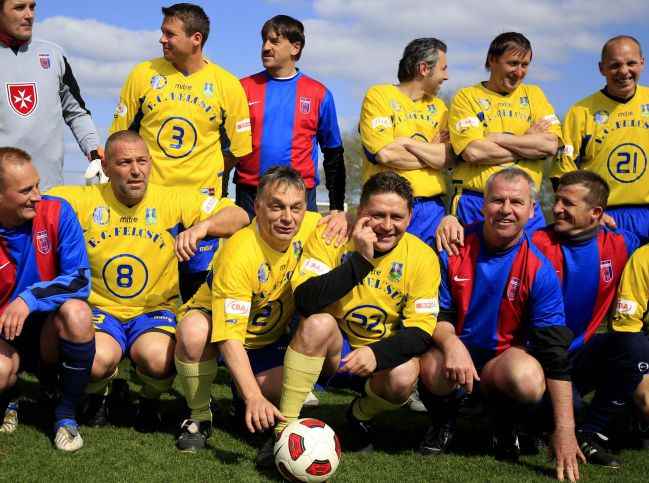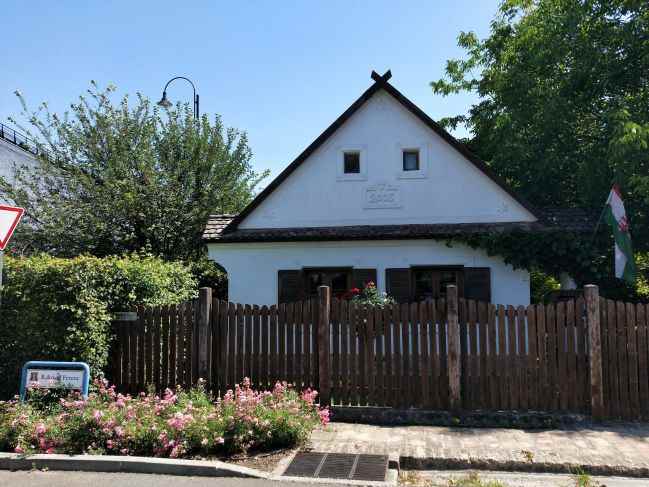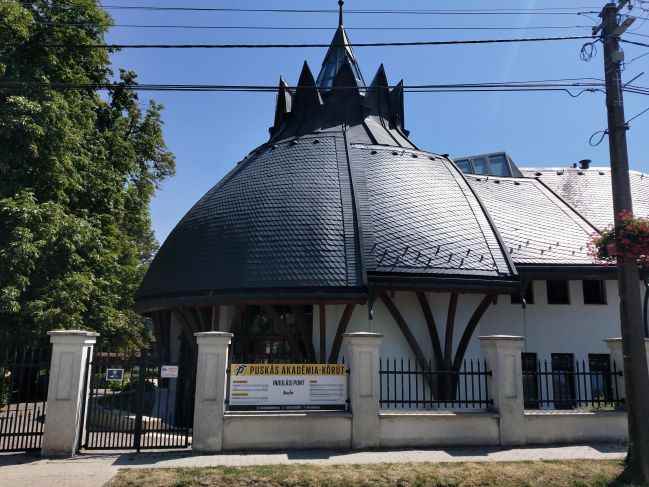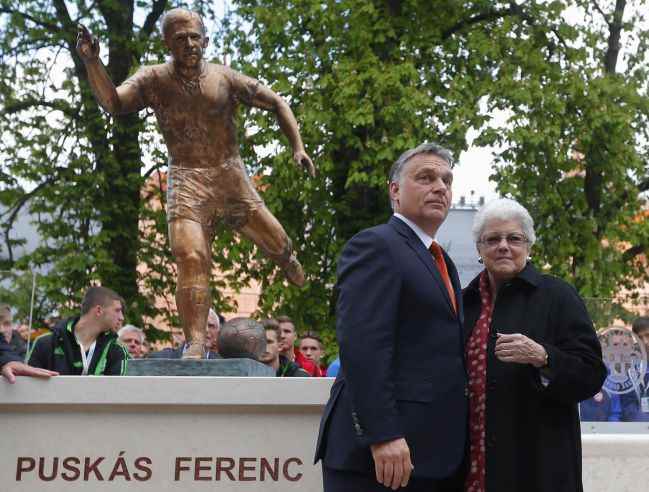For
to travel from Budapest to Felcsut you have to complete a small odyssey through the interior of Hungary, a country painted in color or black and white. The opulence of the center of the capital contrasts with the Soviet-tinged landscape that is observed when moving away from the Danube. An example is Bicske, where time stopped 40 years ago and where the protagonist of ‘Good Bey Lenin!’ could live without being alarmed when she woke up. The tickets are crossed out with a pen, the buses have chipped paint and people wait for them without connecting to their mobile phones, the houses are austere and silence fills the streets. Time goes at a different speed. In just ten minutes, among wheat fields, Felcsút can be glimpsed, the childhood town of Viktor Orbán, Hungarian Prime Minister since 2010 (lived a previous term from 1998 to 2002) until at least 2026 (he was re-elected last spring).
Felcsút gives off another aroma. There is an institute, a nursery, two churches, the occasional modern house, but there is also a silence, a void. “Here there is everything, there are very rich people and very poor people”explains a scruffy passerby who comes out with a white plastic bag from a small grocery store. “I can’t tell you more, I’ve been living for two years”, comment. Less is lavished, even, by the high school teacher who waits at the front door for the delivery man to arrive. “I do not understand English”dispatches in perfect English, but in a doubtful tone.
The town has that illustrious inhabitant, Orbán, who grew up in these streets where they barely live 1,800 inhabitants. A town that has mutated: it went from being the 336th with the highest per capita income in Hungary in 2008 to occupying the first position a year later. And from having a modest soccer team that played in a neighborhood field in the sixth division to having the most gigantic soccer facilities in the country and competing in the Europa League in the 2020-21 campaign. This is how Orbán lives football and this is how he built the ostentatious whim of the Puskás Akadémia. For his critics, Felcsút is “the capital of Orbanistan“.
Orbán, a passionate striker
In 1998, Orbán was elected Prime Minister of Hungary for the first time. His power was not that of now, nor had his shadow reached every corner. At 35 years old, he dared to combine his position with his passion, that of being a footballer. At an amateur level, Orbán played as a center forward, but his quality did not allow him to climb to higher divisions. In 1999, he signed for Felcsút FC, the team from his childhood town. He did not hesitate to return to his origins. Some local media pointed out that his cabinet meetings were sometimes suspended because he was training. While in a suit he felt power, in short he helped as he could to get the team promoted to the fifth division.
His first term ended in 2002 and the team from the Fejér region rose to the fourth category. The club had more liquidity to sign due to the efforts of the politician, who interfered in the management of the entity. In 2005 he hung up his boots when Felcsút FC achieved promotion to the silver division. A meteoric trajectory. He rose to be an assistant coach and president. But the key moment came in 2006when Orban made clear his strategy and ambition with the entity and created a foundation called Puskás FC Kft. Why Puskas?

Enlarge
Viktor Orban, center, at a veterans and friends match.
LASZLO BALOGH / REUTERS
From Felcsút FC to Puskás Akadémia without the ‘yes’ of the Magyar genius
In order to give the club more notoriety, Orbán looked for a legend. Enthusiastic about the magical Magyars of the 50s and the splendor of football in his country, the then leader of the opposition knocked on the door of Ferenc Puskás, the legend, the top scorer of the 20th century and the captain of that historic team. . But that Puskás was already in the last days of his existence. Sick in the hospital, Orbán turned to the footballer’s wife and raised the idea of giving up the Puskás brand to create a foundation and give the Félcsut club its name.. His wife, Hunyadvári Erzsébet, who would die in 2015, signed the transfer of his brand to György Szöllösi, a communicator friend of Orbán.

Enlarge
Viktor Orbán’s house just 13 steps from the Puskás Akadémia mega-complex.
On November 17, 2006, Puskás died of pneumonia. Since the year 2000 he was sick with Alzheimer’s. Just nine days later, Orbán fulfilled his first dream. Felcsút FC was renamed Puskás Akadémia, an ideal moment to pay homage to the footballer who became a legend. Years later, in 2012, the widow of Puskás would give her husband’s belongings and memories to the academy, which built a museum in this small town. The former Real Madrid player had never set foot in this town 50 kilometers from Budapest.
This movement boiled the blood of other historical entities, especially Honved, where ‘Pancho’ had played. His first visit to the Pancho Arena, as the new stadium was baptized (3,814 spectators), ended with a 4-0 win for the Aquincenses after the local team forced them to remove the banners in tribute to Puskas. The visiting fans, in a stadium where they were the majority, chanted the famous song in the country of “you can’t buy legends”. Two years earlier, in 2010, Orbán had returned to a political power that he has not left yet. “It was usual to see him in the box, where great personalities and businessmen met. The truth is that refereeing there is always complicated,” says a Spanish coach who spent several years at an NBI club.
The regeneration of football and the TAO system
Now as prime minister again, Orbán promoted a law to regenerate Hungarian sport (water polo, soccer, volleyball, handball, basketball…) and bet on the academies. The first big measure was the remodeling and construction of new stadiums. The jewel in the crown was the Puskas Arena, located in Budapest, a work involved in the scandal that cost 575 million and which hosted, for example, one of the groups of the last Euro 2021. In order to carry out all these mammoth works, including the ones he had in mind in his club, Orbán created the TAO system, through which large companies could have extensive tax advantages if they invested in these sports.
“They wanted to promote the sport in Hungary, create new stadiums, innovate. For example, we told them that they could use GPS in training and they said yes; they were open to progress”explains a former coach who spent several years in Hungary and saw the evolution of a Puskás Akadémia that in 2012 began the construction of a new stadium with a capacity that doubled the population of the town. To that we had to add eight soccer fields with new generation grass, a school, a residence, a convention room, gyms, a pavilion… “They were spectacular, unique, it is difficult for other parts of Europe to have these facilities. It is difficult for a child from Barça or Madrid to be like this,” says the former coach. And all this just 13 steps from Orbán’s house in Felcsút, adorned with various Hungarian flags and security cameras. The total investment to build this mega-complex was 120 million euros.

Enlarge
One of the buildings of the Puskas Akadémia.
The system that Orbán devised was perfect, as a Hungarian journalist familiar with the entire growth process of the project recounted: “Most of the support went to the Felcsút Foundation. They got almost 37 billion guilders (100 million euros) from this source. Most of the companies that gave their tax to the foundation (instead of the state) are close to the government or to Orbán himself. Most of the income of these companies comes directly or indirectly from the Hungarian state. Its other source of income is TV rights, which come indirectly from the state, which pays MTV, the company that has the rights. It is a covert financing of the state presided over by Orbán to the Orbán club”. And close: “There is a growing trend of companies with good relations with the government that get a lot of benefits from state contracts to spend a small part of their income on football (especially in Felcsút), as it is important to the government”closes one of the sources.
Established in power and despite hanging up his boots in 2005, the Prime Minister continued to play football once a week with the coaches and employees of Puskás Akadémia and Videoton, a club that trained at his facilities and signed a membership agreement. collaboration. “He lived right there, he was crazy about football. On the pitch he was a not very physical and very technical striker. He liked the touch game. Off the field he was a person concerned about football, who wanted to listen and learn new things”adds the same source, who participated in those meetings.
In order to balance control of the state and the club, he stepped aside and handed over the presidency to his friend Lörinc Mészáros, a Felcsút plumber who has become the richest person in Hungary. (according to Forbes in 2021 he accumulated 1.2 trillion dollars) by creating a construction company and winning several public tenders awarded by the Orbán government. In addition, joining the FIDESZ party, he became the mayor of the town of Felcsút.

Enlarge
Vikor Orban and Puskas’s wife, in 2014.
LASZLO BALOGH
Puskás Akadémia arrives in Europe
In 2013, the Puskás Akadémia quarry project took a backseat. There were hardly any grassroots players in the first team and the club’s policy focused on signing higher-level players. In 2014 promotion to Nemzeti Bajnokság I (First) was achieved and in the last four seasons Orbán’s team has finished among the top four in the championship, has even come to fight for the title against Ferencvaros. In the 2020-21 campaign he made his debut in Europe.
66% of the squad this season is Hungarian, but there are only six footballers from the academy (many of them arrived at youth age) consolidated in the first team, which sails in fourth position in the championship. Orbán’s modest house in his town contrasts with his real (future) home just seven kilometers away. The Orbán palace, this is how the property located in Hatvanpuszta is known. In a recent article in El Paísit is commented that “what has been proven is that the land is in the name of Gyozo Orbán, who for a few years rented it to Lorinc Mészárossupposedly to store agricultural machinery”. Orbán, Mészáros and ostentatious projects, the Felcsút triangle with the Puskás Akadémia is repeated with the so-called ‘Orbán Palace’.
From 1998 to 2022, in these 24 years of hard work, Orbán has changed the panorama of Felcsút tied to power. The club has gone from playing in the sixth division to being one of the candidates for the League title. It has gone from having a regional soccer field to having one of the most pompous facilities in Europe, within the reach of few of the best clubs on the continent. And all this with money from companies like OTP Bank or the MOL Group (in charge of oil and gas in Hungary). What will become of all this when Felcsút ceases to be the city of the president? “It seems that these facilities are going to be ruined before Orbán has to hand over the post of prime minister. Facility maintenance is still expensive. That’s why teams and foundations have been able to spend TAO money on this for a few years now.”ditch one of the connoisseurs of the reality of Puskás Akadémia, the whim of Orbán, a reflection of how power is managed in dark Hungary.
